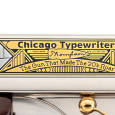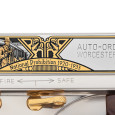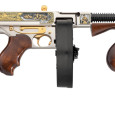THIS ISSUE IS CLOSED.
 Found in the hands of gangsters, motorized bandits, and the lawmen who pursued them, the Thompson was known as the “Chicago Typewriter”, because the sound of a Thompson being fired resembled the sound of typing on a typewriter in the distance throughout south-side Chicago. It has been referred to as the gun that made the twenties roar. Now, decades later, we are still fascinated by this firearm and by this era.
Found in the hands of gangsters, motorized bandits, and the lawmen who pursued them, the Thompson was known as the “Chicago Typewriter”, because the sound of a Thompson being fired resembled the sound of typing on a typewriter in the distance throughout south-side Chicago. It has been referred to as the gun that made the twenties roar. Now, decades later, we are still fascinated by this firearm and by this era.
The magnitude of the color and turbulence of this gangster era is ironic, as our nation was trying to cleanse itself and start the decade of the twenties afresh with Prohibition. But from 1920 until 1933, when alcohol was federally prohibited, organized crime was thrust into the era of Big Business, starting with bootlegging, speakeasies and rum running, and then expanding into larger crimes. Thompsons were necessities for these gangsters, and soon, they would be necessities for the lawmen that chased them. It is said that the Thompson was “born in battle”. As one researcher says of the Thompson: “A man carrying a Thompson was not to be trifled with. He was either a bad man to be avoided, or he was the law chasing a bad man.”
The Chicago Typewriter Thompson is issued exclusively by America Remembers on a working Thompson Semi-Automatic in caliber .45 ACP with the ever popular round drum magazine. In thrilling detail, this handsome Tribute chronicles the fascinating era of the gangsters and lawmen of the 1920s and 30s. Craftsmen commissioned specifically for this project by America Remembers decorate each working Thompson in stunning 24-karat gold and nickel with a blackened patinaed background to highlight the details of the artwork that captures the spirit of the time, when the Thompson reigned as the most desired firearm around.

The Gun That Made the Twenties Roar!
In the years following World War I, America fell victim to crime waves of epic proportions. The first started after the Prohibition Amendment of 1918. The sweeping decision to make alcohol illegal across the United States was intended to help keep the peace, but instead, it helped spark the rise of organized crime in America. Bootlegging mobsters, such as Dutch Schultz and Al Capone, ruled the criminal underworld and launched the “Gangster Era.”
When the stock market crashed in 1929 and triggered the Great Depression, a new breed of gangster emerged. Bank robbers became the new gangsters. At the time, many Americans considered banks the “bad guys” and blamed financial institutions for the suffering and hardship that had crippled the country. So there were plenty of small town folks who saw bank robbers such as Bonnie and Clyde as modern day Robin Hoods.
The bold bank bandits became more and more popular with the common folk, who understood their plight. The names of the gangsters from this time are legendary. However, it was also during this period that the F.B.I. came into prominence, and these bank robbers earned a different reputation from America’s top cop, the Director of the Bureau of Investigation: J. Edgar Hoover, and a battle was born with the Thompson submachine gun at the center of it. The G-Men weren’t officially issued their first Thompson submachine guns until 1935. Once agents started using the Tommy Gun, the odds were made a little more even. The Thompson let them unload a high volume of .45 caliber rounds, enough to stop fleeing vehicles and put the fear of the law into anyone on the other end of the barrel. Throughout the epic struggle between gangsters and G-Men during the 1920’s and 1930’s, the “Chicago Typewriter” played a pivotal role.
The Gangster Era of the 1920’s and into the 1930’s is a uniquely American period that continues to intrigue and fascinate us today. And the history of the era is responsible for much of the lore and legend we associate with them as an organization, along with the key figures who pitted themselves against the gangsters of the day. Newsmen and biographers have memorialized them, Hollywood has glamorized them, and Americans have marked them as the legends of this turbulent time.
After the chaos and crime of the 1930s, war erupted in Europe and the Pacific. In combat, General Thompson’s creation was finally able to fulfill its original mission as a fierce yet lightweight automatic firearm for the infantry. The United States military went on to use the Thompson in the Korean War as well as in Vietnam. The FBI kept Tommy Guns in their arsenal up until 1976. To this day the Thompson remains one of the most widely recognized and respected firearms in the world.
The era of Prohibition is long gone, but the thrills and exploits of the legendary mobsters, gangsters, and law enforcement alike will be remembered forever. This historical Tribute magnificently captures the drama and excitement of this historic period of American history, when gangsters ruled and law enforcement rose to the challenge, capturing many of its “public enemies”, and restored law and order to the streets and towns of America. Now is your opportunity to preserve this exciting era and the lawmen and outlaws who made their mark on history with the Chicago Typewriter.

The right side of the receiver features Chicago Typewriter, with the official Thompson logotype in gold and The Gun That Made The 20’s Roar displayed underneath. To the left of the center image, you’ll find a standoff between two gangsters and two lawmen in a speakeasy—all four holding fast to their Thompsons. To the right of the center image, you’ll find a police car chasing a getaway, with a bandit riding alongside holding his Thompson in the air on a starry Chicago night. Underneath, you’ll find 18th Amendment, 1920. To the far right, you’ll find a lawman pointing a Thompson with the city skyline of Chicago behind him.

The left side of the receiver features National Prohibition 1920-1933 in a banner. To the left, you’ll find two lawmen keeping guard outside of a warehouse with their Thompsons at the ready. Further left, you’ll find lawmen destroying barrels of alcohol from a warehouse. To the far left, you’ll find a WANTED sign for a criminal, with a $1000 reward—quite a lot of money then! All artwork is featured in 24-karat gold and mirror-polished nickel on the receiver.
Shipping Procedures
Since the Chicago Typewriter Thompson is a working Thompson semi-automatic submachine gun, we will arrange delivery through a licensed firearms dealer of your choice. You do not need a special license to own the historic firearm. Anyone who can own a standard hunting rifle can own this, in most communities. (Not available in CA, CT, MD, NY)
Order
I wish to reserve the “Chicago Typewriter Thompson,” a working Thompson semi-automatic submachine gun, at the current issue price of $3,195*. Each Thompson is numbered and registered within the limited edition of 500, and is accompanied by a numbered Certificate of Authenticity. Thirty day return privilege.
Please charge my credit card a deposit of $195 per Thompson. I will pay the balance at the rate of $100 per month, with no interest or carrying charge.
* All orders are subject to acceptance and credit verification prior to shipment. Sales tax is required in certain states and will be added. Shipping and handling will be added to each order. Virginia residents please add sales tax.





